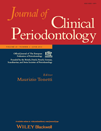Gingival labial recessions in orthodontically treated and untreated individuals: a case – control study
Conflict of interest and sources of funding statement
The authors declare that they have no conflict of interests. No external funding, apart from the support of the authors' institution, was available for this study.
Abstract
Objectives
To evaluate the long-term development of labial gingival recessions during orthodontic treatment and retention phase.
Material and Methods
In this retrospective case–control study, the presence of gingival recession was scored (Yes or No) on plaster models of 100 orthodontic patients (cases) and 120 controls at the age of 12 (T12), 15 (T15), 18 (T18), and 21 (T21) years. In the treated group, T12 reflected the start of orthodontic treatment and T15 – the end of active treatment and the start of retention phase with bonded retainers. Independent t-tests, Fisher's exact tests and a fitted two-part “hurdle” model were used to identify the effect of orthodontic treatment/retention on recessions.
Results
The proportion of subjects with recessions was consistently higher in cases than controls. Overall, the odds ratio for orthodontic patients as compared with controls to have recessions is 4.48 (p < 0.001; 95% CI: 2.61–7.70).
Conclusions
Within the limits of the present research design, orthodontic treatment and/or the retention phase may be risk factors for the development of labial gingival recessions. In orthodontically treated subjects, mandibular incisors seem to be the most vulnerable to the development of gingival recessions.




